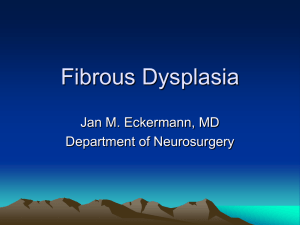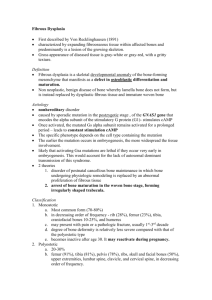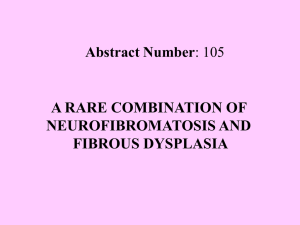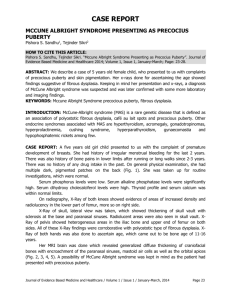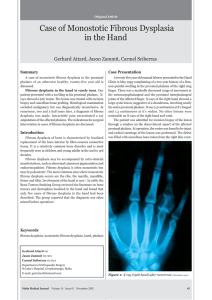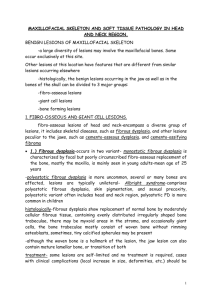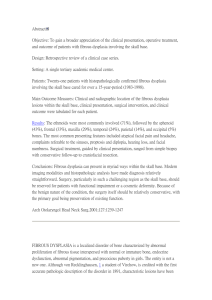FIBRO OSSEOUS LESIONS OF JAW
advertisement
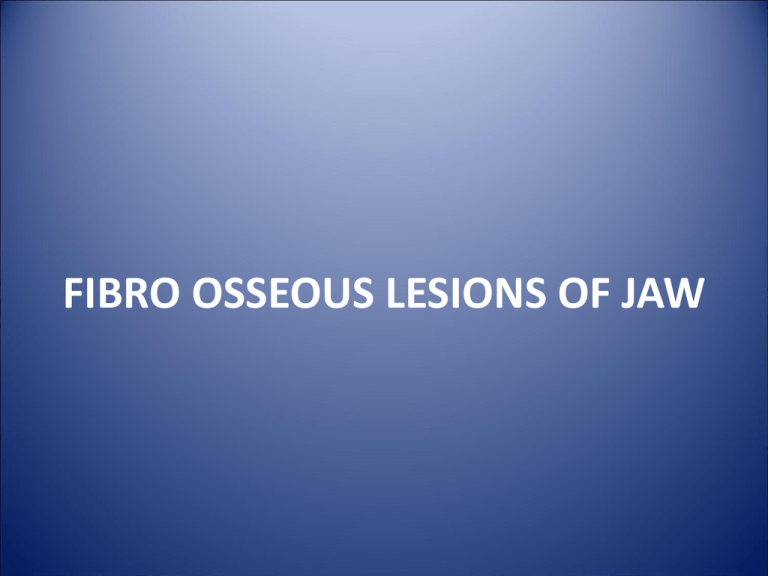
FIBRO OSSEOUS LESIONS OF JAW Fibro Osseous Lesions of Jaw • It is variety of disorders of the jaw bones characterized histologically by replacement of normal bone by cellular fibrous tissue within which varying amount of predominantly woven bone and acellular islands of mineralized tissue develops. • These lesions can not be distinguished by histology alone. Fibro Osseous Lesions of Jaw • Their diagnosis is done by clinical and radiographic features. • These lesions are divided in the groups. A. OSSEOUS DYSPLASIA – Fibrous dysphasia – Monostotic – Polyostotic – Cemento osseous displasia, periapical cemental dysplasia, focal cemento osseous dsplasia, Gigantiform dysplasia Fibro Osseous Lesions of Jaw B. BENIGN NEOPLASIA – Ossifying fibroma – Cemento ossifying fibroma Fibrous Dysplasia of Bone • It is the disease of the bone involving several bones in the body • Two terms are applied for the disease Monostotic and Polyostotic Monostotic Fibrous Dysplasia • It is common than the polyostotic form • Any bone may be involve in the body lesion arises most frequently in limb bone, rib or skull particularly the jaws • In Jaw bones more common in maxilla than mandible Monostotic Fibrous Dysplasia • When Maxilla affected, the adjacent bones such as Zygoma and sphenoid bone may also be involved and then the disease is not strictly monostotic, How ever the distribution is restricted to contiguous bones, the anatomical area the pattern is not typically associated with polyostotic disease. Monostotic Fibrous Dysplasia • For these reasons, it has been suggested that the term is called Craniofacial Fibrous Dysplasia in such circumstances. • The majority of the patients are seen in childhood and adolescence, but occasionally in adults which diagnosed late • It is pain less swelling of the Jaws gradually increasing which is not well cercumscribed and causes increasing facial asymmetry. Monostotic Fibrous Dysplasia • The enlargement is usually smooth often fusiform in outline and is more pronounced buccally than lingually or palatally. • When the maxilla is involved there is usually increased prominency of cheak and buccal expansion distal to canine, which extend to involve tubrasity. Monostotic Fibrous Dysplasia • The canine fossa is obliterated and involve the maxillary sinus in Maxillary lesions. • In maxillary lesions Zygomatic process and floor of the orbit and orbital contents may be displaced • In the some cases the growth is more rapid and extensive, the exohthemass and proptosis. Monostotic Fibrous Dysplasia • Mandibular lesions occur more frequently in the molar and pre molar region if the lower border is involve there may be obvious protuberance and increase in depth of the jaw. • In either jaw there may be some malalignment tipping or displacement of the teeth and in children any teeth involved by the lesion may fail to erupt. X-RAY FINDINGS • The lesion may be radiolucent initially but as degree of trabeculation increases the lesion become malted and opaque. • Lesion appears ground-glass or orange-peelstippling effect. • Roots of teeth in involved area may be separated and teeth may be displaced.
